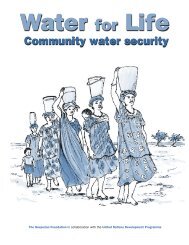Integrated Flood Management-Concept Paper.pdf - APFM
Integrated Flood Management-Concept Paper.pdf - APFM
Integrated Flood Management-Concept Paper.pdf - APFM
You also want an ePaper? Increase the reach of your titles
YUMPU automatically turns print PDFs into web optimized ePapers that Google loves.
Stakeholder consultation should provide for<br />
the participation of minorities and indigenous<br />
people and the socially or economically weaker<br />
sections of society, and flood planning should<br />
account for the interests of other vulnerable sections<br />
of society, such as children and the elderly.<br />
Indigenous knowledge of coping with floods<br />
should inform the mix of measures evaluated.<br />
At the same time, the pace of human induced<br />
changes to the hydrological and climatic systems<br />
means that the adequacy of adopted and proposed<br />
measures need to be regularly reassessed. The<br />
form of participation may vary, depending upon<br />
the social, political and cultural makeup of the<br />
society. Participation can also take place through<br />
democratically elected representatives and spokespersons<br />
or through the various user groups such<br />
as water users associations, forest user groups<br />
and other interested parties. As IWRM and the<br />
IFM are not isolated issues, and usually mirror<br />
society’s general characteristics and problems,<br />
the adopted model for stakeholder participation<br />
will vary with the specific circumstances.<br />
Bottom-up and Top-down: A wide range of activities<br />
and agencies are involved in the successful<br />
implementation of disaster management strategies.<br />
They involve individuals, families and communities<br />
along with a cross-section of civil society such as<br />
research institutions, governments and voluntary<br />
organizations. All these institutions play vital roles<br />
in transforming warnings into preventive action.<br />
Members from all sectors, involving different<br />
disciplines must be involved in the process and<br />
carry out activities that support the implementation<br />
of disaster mitigation and management plans.<br />
An extreme “bottom-up” approach risks fragmentation<br />
rather than integration. On the other hand,<br />
the lessons from past attempts at “top-down”<br />
approaches clearly indicate that local institutions<br />
and groups tend to spend a great deal of<br />
effort subverting the intentions of the institution<br />
supposedly responsible for overall management<br />
of the basin. It is important to make use of the<br />
strengths of both the approaches in determining<br />
the appropriate mix.<br />
Integration of Institutional Synergy: All institutions<br />
necessarily have geographical and<br />
functional boundaries. It is necessary to bring<br />
all the sectoral views and interests to the decision-making<br />
process. All the activities of local,<br />
regional and national development agencies<br />
should be coordinated at the appropriate level.<br />
These may include departments and ministries,<br />
as well as private enterprises working in the fields<br />
of agriculture, urban and watershed development,<br />
industry and mining, transport, drinking<br />
water and sanitation, poverty alleviation, health,<br />
environmental protection, forestry, fisheries<br />
and all other related fields. The challenge is to<br />
promote coordination and cooperation across<br />
functional and administrative boundaries. River<br />
basin committees or organizations, at basin or<br />
sub-basin levels, can provide appropriate forums<br />
for such coordination and integration. The best<br />
examples of such practice are likely to be found<br />
where circumstances required the coordination<br />
and cooperation of existing institutions.<br />
Adopt <strong>Integrated</strong> Hazard <strong>Management</strong><br />
Approaches<br />
Certain hazards within the basin, such as landslides,<br />
have the potential to modify the flood<br />
risks downstream and, combined with floods,<br />
can generate mudflows. Storm surges associated<br />
with tropical cyclones greatly influence the<br />
flooding in estuarine areas and have the potential<br />
to travel tens of kilometres upstream thereby<br />
influencing riverine flooding. Such hazards call<br />
for a multi-hazard approach. A holistic approach<br />
to emergency planning and management is<br />
preferable to a hazard-specific approach, and<br />
IFM should be part of a wider risk management<br />
system. This approach fosters structured information<br />
exchange and the formation of effective<br />
organizational relationships.<br />
The integrated hazard management approach<br />
includes development concerns along with<br />
emergency planning, prevention, recovery<br />
and mitigation schemes, and offers a better<br />
treatment of common risks to life, as well as<br />
more efficient use of resources and personnel. It<br />
consequently ensures consistency in approaches<br />
to natural hazard management in all relevant<br />
national or local plans. Early warnings and<br />
forecasts are key links to the series of steps<br />
19
















